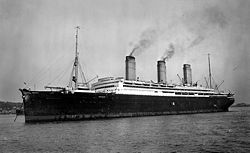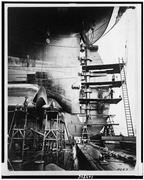Imperator class
|
The emperor
|
||||||||||||||
|
||||||||||||||
|
||||||||||||||
|
||||||||||||||
|
||||||||||||||
The largest German passenger ships of the HAPAG shipping company built in Hamburg belonged to the Imperator class . In order to be able to guarantee a weekly departure from Europe to America , Albert Ballin pushed through the construction of a fleet of fast steamers. The type ship Imperator was built by AG Vulcan , the two sister ships Vaterland and Bismarck by Blohm & Voss , whereby the size of the ships was increased each time. The construction of these ships was also a response to the previously started construction of the Olympic class of the White Star Line , to which the Titanic also belonged.
The homeland of the Emperor class is still the largest ever operated under the German flag passenger ship.
Mission history
Emperor
The Imperator (HAPAG used the male article at the request of Kaiser Wilhelm II ) was built at the Vulkan shipyard in Hamburg. When it was launched on May 23, 1912, with 52,117 gross register tonnes, it was the largest ship in the world at the time and the type ship of the ship class named after it. The ship was led by a commodore and four staff captains . The Emperor's godfather was Kaiser Wilhelm II. In 1913 the steamer was delivered.
After the First World War, the Imperator was handed over to the British Cunard shipping company, which operated it under the name RMS Berengaria until February 1938 .
Fatherland
On April 3, 1913, the Vaterland was launched as the second ship of the Imperator class on the Hamburg-America Line at Blohm & Voss in Hamburg and was finally completed on April 29, 1914. It had a length between the perpendiculars of 276.59 m and a length over all (Lüa) of 289.56 m, a width of 30.48 m and 19.51 m side height. This replaced the Emperor as the largest ship in the world. The Vaterland had 54,282 gross register tonnes and was designed for 3,677 passengers and 1,234 crew members.
The ship was in New York City from the outbreak of war and was laid up there by HAPAG . When the United States entered the First World War , the United States seized the ship and renamed it Leviathan on September 6, 1917 . From 1922 to 1934 she sailed the North Atlantic for the United States Lines and was scrapped in Rosyth, Scotland, from February 1938 .
Bismarck
The third ship of the Imperator class was the Bismarck ; it was laid down at Blohm & Voss in 1913 and launched on June 20, 1914. The beginning of the First World War put further construction on hold; the ship was launched in Hamburg and awarded to Great Britain in 1918 as a reparation payment . The Bismarck was Blohm & Voss incl. Shipyard test drive completed and after the handover on 1 April 1922, the White Star Line in Southampton in Majestic renamed. Like the two sister ships, it was the largest ship in the world at the time, at 56,551 GRT. The Majestic was decommissioned in 1936 and subsequently served as a training ship for the British Navy until it was destroyed by fire shortly after the outbreak of World War II and then scrapped.
literature
- Robert D. Ballard , Ken Marschall : Lost Liners - From the Titanic to Andrea Doria - the glory and decline of the great luxury liners. Translated from the English by Helmut Gerstberger. Heyne, Munich 1997, ISBN 3-453-12905-9 .
- Arnold Kludas : The German express steamers. The imperator class - the climax of an era. In: Deutsches Schiffahrtsarchiv, Volume 8. Kabel, Hamburg 1985, ISSN 0343-3668 , pp. 147-164 ( PDF ).
- Eberhard Mertens (ed.): The Hapag giants of the Imperator class. The history of the luxury ships Imperator, Vaterland, Bismarck in pictures and contemporary documents. Olms, Hildesheim 1974, ISBN 3-487-08083-4 .
- Thorsten Totzke: The ships of the Imperator class in pictures. 3. Edition. epubli, Berlin 2019, ISBN 978-3-7485-1784-9 .
- Hans Jürgen Witthöft: Ballin's thick steamers - Imperator, Fatherland, Bismarck. Koehler, Herford 1974, ISBN 3-7822-0100-0 .
- Peter Zerbe: The big German passenger ships "Imperator", "Vaterland", "Bismarck". Nautik Historie Verlag, Hamburg 1999, ISBN 3-929231-11-5 .
Web links
- Imperator / RMS Berengaria , Vaterland / Leviathan , Bismarck / RMS Majestic . In: AtlanticLiners.com (English)
Notes and individual references
- ↑ Data refer to the Imperator at commissioning
- ↑ see also under sailor culture , ship names
- ↑ Staff captain - on large passenger ships, a captain in turns who relieves his superiors of some of the social duties
- ↑ see also ship surveying , Moorsom system, examples




